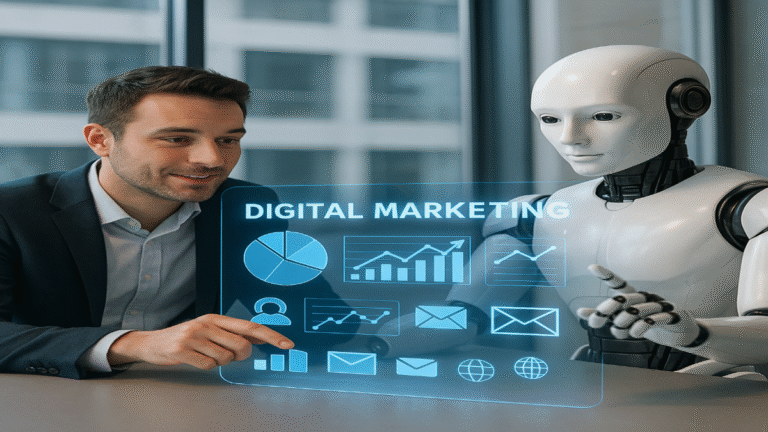Meta Description
Discover why digital marketing has become the dominant online strategy for businesses in 2025. Learn about its cost-effectiveness, measurable results, targeted approach, and how it helps build meaningful customer relationships in today’s digital landscape.
Introduction
In today’s hyperconnected world, businesses can no longer rely solely on traditional marketing methods to reach their target audience. The digital revolution has fundamentally transformed how companies communicate with consumers, leading to the meteoric rise of digital marketing as the dominant online strategy. With over 5.3 billion internet users worldwide as of 2025, representing approximately 66% of the global population, digital marketing offers unprecedented opportunities to connect with potential customers where they spend a significant portion of their time – online.
Digital marketing encompasses a diverse range of strategies and tactics, from search engine optimization (SEO) and content marketing to social media campaigns and email marketing. Its dominance stems from its ability to deliver targeted, personalized, and measurable marketing efforts that traditional approaches simply cannot match. For businesses of all sizes, understanding why digital marketing has become the go-to strategy is crucial for staying competitive in an increasingly digital marketplace.
The Evolution of Digital Marketing
The journey of digital marketing began with the dawn of the internet era. What started as simple banner advertisements and basic email campaigns has evolved into a sophisticated ecosystem of interconnected strategies. The early 2000s saw the rise of search engines like Google, which revolutionized how businesses could be discovered online. Social media platforms emerged in the mid-2000s, creating new channels for brand-consumer interactions.
By 2010, smartphones had become ubiquitous, ushering in the mobile marketing revolution. Today, we stand at the frontier of AI-driven marketing automation, personalization at scale, and immersive technologies that continue to reshape the digital marketing landscape. This evolution reflects the adaptability and resilience of digital marketing as a strategy that consistently embraces technological advancements to deliver better results.
The significant milestones in digital marketing’s evolution highlight how it has continuously reinvented itself to remain relevant and effective in an ever-changing digital environment. This adaptability is a key reason why digital marketing continues to dominate online strategies for businesses worldwide.
Cost-Effectiveness: Maximum Impact with Minimal Investment
One of the most compelling reasons for digital marketing’s dominance is its remarkable cost-effectiveness compared to traditional marketing channels. Traditional advertising methods like television commercials, radio ads, and print media often require substantial investments with limited targeting capabilities. In contrast, digital marketing offers flexible budget options that make it accessible to businesses of all sizes.
Small startups with limited resources can leverage strategies like content marketing and social media to establish their presence without breaking the bank. Even with modest budgets, digital campaigns can generate significant returns when strategically implemented. The pay-per-click (PPC) advertising model exemplifies this advantage – businesses only pay when users take specific actions, ensuring that marketing dollars are spent efficiently.
Consider these statistics that highlight the cost advantages:
- Digital marketing can cost 62% less than traditional marketing while generating approximately three times as many leads
- Email marketing delivers an average ROI of 3,800% or $38 for every $1 spent
- Content marketing costs 62% less than outbound marketing but generates three times more leads
These numbers underscore why businesses increasingly allocate larger portions of their marketing budgets to digital channels. The ability to achieve maximum impact with minimal investment makes digital marketing an irresistible proposition for businesses seeking efficient growth strategies.
Precise Audience Targeting: Reaching the Right People
Perhaps the most revolutionary aspect of digital marketing is its unprecedented ability to target specific audiences with laser precision. Unlike traditional marketing’s broad-brush approach, digital marketing allows businesses to direct their messages to exactly who needs to see them, when they need to see them.
Advanced targeting options available through platforms like Facebook Ads and Google Ads enable marketers to define audiences based on:
- Demographics (age, gender, income level, education)
- Geographic location (country, city, or even specific radius around a location)
- Psychographics (interests, values, attitudes, lifestyle choices)
- Online behavior (websites visited, purchase history, app usage)
- Lookalike audiences (people similar to existing customers)
This granular level of targeting minimizes wasted ad spend and maximizes campaign effectiveness. For example, a local bakery can show ads exclusively to people within a 5-mile radius who have previously searched for “fresh bread” or “bakeries near me.” This precision ensures that marketing messages reach those most likely to convert, significantly improving return on investment.
Furthermore, retargeting capabilities allow businesses to reconnect with users who have previously engaged with their brand but didn’t complete a purchase. These personalized follow-ups have been shown to increase conversion rates by up to 150%, demonstrating the power of strategic audience targeting in digital marketing.
Measurable Results: Data-Driven Decision Making
Unlike traditional marketing channels where results can be difficult to quantify, digital marketing provides comprehensive, real-time analytics that transform marketing from an art into a data-driven science. This measurability is a fundamental reason why digital marketing continues to dominate online strategies.
Digital marketing platforms offer detailed insights into campaign performance through metrics such as:
- Impression counts and reach
- Click-through rates (CTRs)
- Conversion rates
- Cost per acquisition (CPA)
- Return on ad spend (ROAS)
- Customer lifetime value (CLV)
- Engagement metrics (time on site, bounce rate, pages per session)
These metrics enable marketers to make informed decisions based on actual performance data rather than intuition. A/B testing further enhances this capability by allowing businesses to compare different approaches and determine which strategies yield the best results. For instance, testing two different email subject lines can reveal which drives higher open rates, informing future campaign decisions.
The ability to track the customer journey from initial awareness to final purchase provides unprecedented visibility into the effectiveness of marketing efforts. This closed-loop reporting system allows businesses to attribute sales and conversions to specific marketing activities, calculating precise ROI for different channels and campaigns.
According to a recent survey by Deloitte, 49% of marketers cite “better ability to measure ROI” as a primary reason for increasing digital marketing budgets. This data-driven approach minimizes guesswork, reduces wasted resources, and continuously improves marketing performance through iterative optimization.
Global Reach: Breaking Geographic Barriers
Digital marketing has effectively demolished geographic boundaries that once limited business growth. With just an internet connection and strategic digital marketing, even small businesses can establish a global presence and reach customers worldwide.
This unprecedented global reach presents extraordinary opportunities:
- A local artisan can sell handcrafted products to collectors across continents
- Educational institutions can attract international students through targeted campaigns
- Service-based businesses can offer expertise to clients regardless of location
- Niche products can find their perfect audience, even when that audience is geographically dispersed
E-commerce platforms integrated with digital marketing strategies enable businesses to process international transactions seamlessly. Translation services and localization tools help adapt content for different markets, making it accessible to diverse audiences. This global potential dramatically expands the ceiling for business growth beyond what was possible with traditional marketing methods.
The COVID-19 pandemic accelerated this trend, with businesses that successfully pivoted to digital strategies not only surviving but thriving during lockdowns. Those with robust digital marketing frameworks were able to maintain customer relationships and continue operations despite physical restrictions, highlighting the resilience digital strategies offer in an uncertain world.
Relationship Building: Creating Meaningful Connections
While digital marketing is often associated with its technical capabilities, its power to build meaningful connections between brands and consumers represents one of its most valuable assets. Social media platforms, email marketing, and content strategies create ongoing touchpoints that foster loyalty and trust.
Unlike traditional advertising’s one-way communication, digital marketing enables two-way conversations. Businesses can:
- Respond to customer queries in real-time through social media
- Gather feedback through surveys and comments
- Create communities around shared interests related to their brand
- Offer personalized content based on individual preferences and behaviors
These interactions humanize brands and create emotional connections that drive long-term customer loyalty. Content marketing exemplifies this approach by providing value beyond transactional relationships. By creating helpful blog posts, informative videos, or entertaining social media content, businesses position themselves as trusted resources rather than just sellers of products or services.
Email marketing, when executed thoughtfully, nurtures these relationships through personalized communication at scale. Segmented email campaigns that deliver relevant content based on user behavior have been shown to increase engagement rates by up to 760%, demonstrating the impact of personalized communication.
Customer relationship management (CRM) systems integrated with digital marketing tools enable businesses to track interactions across multiple touchpoints, creating a cohesive experience that strengthens brand loyalty over time. This relationship-centric approach transforms one-time customers into brand advocates who provide recurring revenue and valuable word-of-mouth marketing.
Flexibility and Adaptability: Responding to Change
The digital marketing landscape is characterized by constant evolution – new platforms emerge, algorithms change, and consumer preferences shift rapidly. While this dynamism presents challenges, it also showcases one of digital marketing’s greatest strengths: its unmatched flexibility and adaptability.
Unlike traditional marketing methods that often require lengthy production timelines and significant sunk costs, digital campaigns can be:
- Launched quickly in response to market opportunities
- Modified in real-time based on performance data
- Scaled up or down depending on results
- Pivoted to new approaches when necessary
This agility allows businesses to experiment with different strategies, learn from results, and continuously refine their approach. During the COVID-19 pandemic, this adaptability proved invaluable as businesses rapidly shifted messaging, adjusted targeting, and embraced new channels to maintain relevance in changing circumstances.
The integration capabilities of digital marketing tools further enhance this flexibility. Marketing automation platforms can connect with CRM systems, e-commerce platforms, and analytics tools to create a cohesive ecosystem that adapts to business needs. This interconnected approach ensures that marketing efforts remain aligned with broader business objectives despite changing conditions.
As new technologies like artificial intelligence, augmented reality, and voice search gain prominence, digital marketing’s adaptable framework allows businesses to incorporate these innovations into their strategies. This forward-looking flexibility ensures that digital marketing will continue to evolve and maintain its dominance in the online strategy landscape.
Mobile Marketing: Reaching Consumers on the Go
The proliferation of smartphones has fundamentally changed consumer behavior, with mobile devices becoming the primary means of accessing the internet for billions of people worldwide. In 2025, mobile devices account for approximately 60% of global website traffic, making mobile marketing an essential component of digital strategy.
Digital marketing’s strength lies in its ability to reach consumers through these omnipresent devices with:
- Mobile-optimized websites that provide seamless experiences
- Location-based marketing that delivers relevant messages based on physical location
- App-based strategies that engage users through branded applications
- SMS and push notification campaigns that capture immediate attention
The mobile-first approach has become standard practice for effective digital marketing, recognizing that many consumers first encounter brands through mobile searches or social media apps on their phones. Google’s mobile-first indexing further emphasizes this shift, prioritizing the mobile version of websites for ranking purposes.
Mobile marketing also enables unique engagement opportunities through features like click-to-call buttons, map integrations, and mobile payment options that simplify the customer journey. These capabilities create frictionless paths to purchase that traditional marketing channels cannot match.
The intimate nature of mobile devices – always within reach and containing highly personal information – allows for unprecedented personalization in marketing messages. This combination of convenience, personalization, and ubiquity makes mobile marketing a powerful component of digital strategy’s dominance.
Integration with Sales: Streamlining the Customer Journey
Digital marketing excels at creating seamless connections between marketing and sales functions, eliminating traditional silos that often hamper business growth. This integration enables a streamlined customer journey from initial awareness through consideration and ultimately to purchase.
The digital marketing ecosystem facilitates this integration through:
- CRM systems that track customer interactions across channels
- Marketing automation tools that nurture leads based on behavior
- E-commerce platforms that reduce friction in the purchasing process
- Analytics that provide visibility into the entire customer journey
Lead scoring mechanisms help identify prospects ready for sales engagement, while automated nurturing sequences maintain relationships with those not yet prepared to purchase. This approach ensures that potential customers receive appropriate communications at each stage of their journey.
Case studies consistently show that businesses with tightly integrated marketing and sales functions achieve 38% higher sales win rates and 36% higher customer retention rates. These impressive outcomes stem from the coherent experience digital integration creates for prospects and customers alike.
Furthermore, the digital ecosystem provides valuable feedback loops between sales outcomes and marketing strategies. When sales representatives identify common objections or questions, marketing teams can develop content that addresses these concerns earlier in the customer journey. This collaborative approach continually refines the path to purchase and improves overall business performance.
Conclusion
Digital marketing’s dominance as an online strategy is neither accidental nor temporary – it represents a fundamental shift in how businesses connect with consumers in the digital age. Its unparalleled combination of cost-effectiveness, precise targeting, measurability, global reach, relationship-building capabilities, adaptability, mobile integration, and sales alignment creates a compelling value proposition for businesses of all sizes and industries.
As we look toward the future, digital marketing’s dominance will likely strengthen further as new technologies emerge and consumer behavior continues to evolve in increasingly digital directions. Artificial intelligence will enable even more sophisticated personalization, while immersive technologies like augmented and virtual reality will create novel engagement opportunities. Voice search and smart devices will open new channels for reaching consumers in contextually relevant moments.
For businesses seeking sustainable growth in today’s competitive landscape, embracing comprehensive digital marketing strategies isn’t just advantageous – it’s essential. Those who master these approaches gain not only immediate performance benefits but also build adaptable marketing frameworks capable of evolving alongside technological advancement and changing consumer preferences.
The question is no longer whether digital marketing should be part of a business strategy, but rather how extensively it should be implemented to maximize competitive advantage. As we’ve explored throughout this article, the evidence overwhelmingly supports going all-in on digital marketing as the dominant strategy for online success in 2025 and beyond.
What digital marketing strategies have been most effective for your business? Share your experiences in the comments below!





Элитная мебель для исключительных личностей.
Мебель премиум-класса [url=https://byfurniture.by]https://byfurniture.by[/url] .